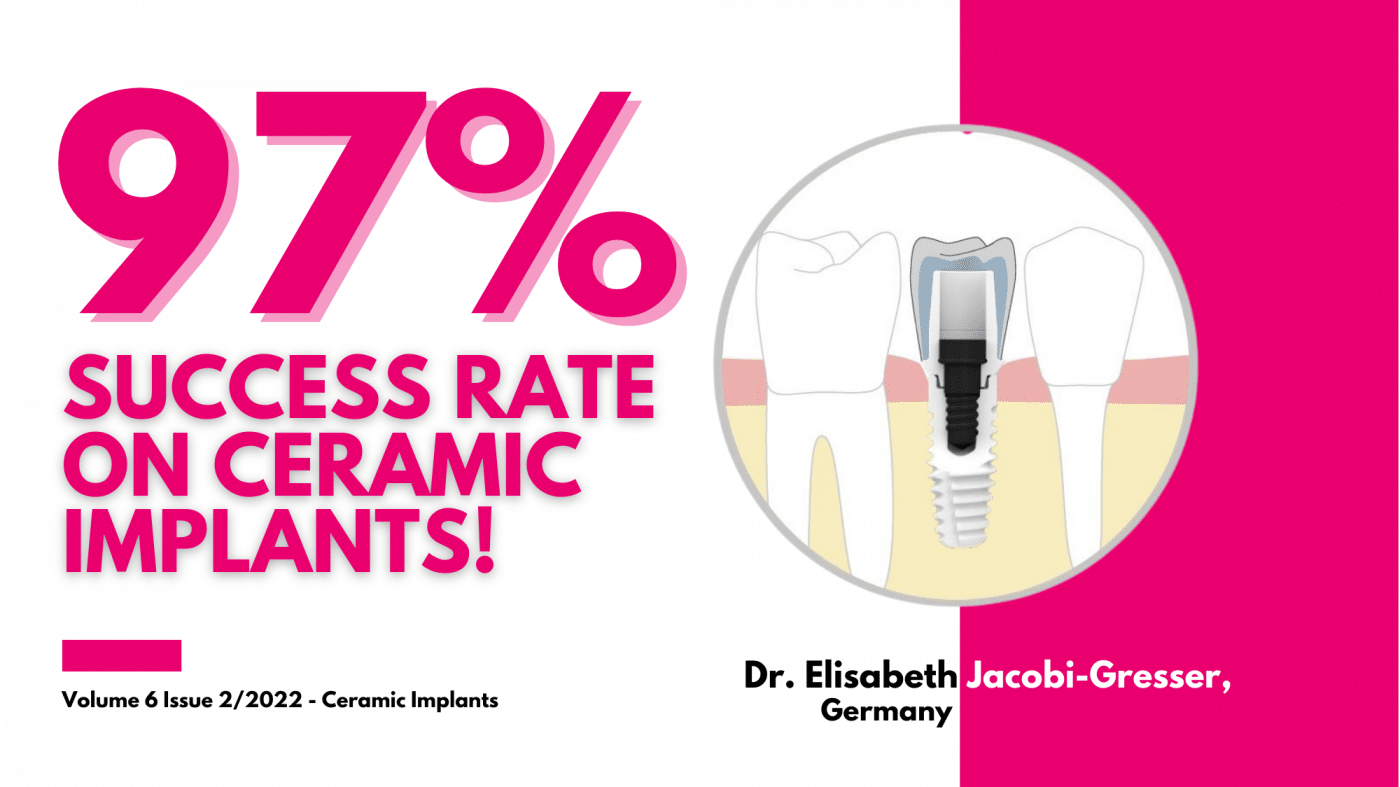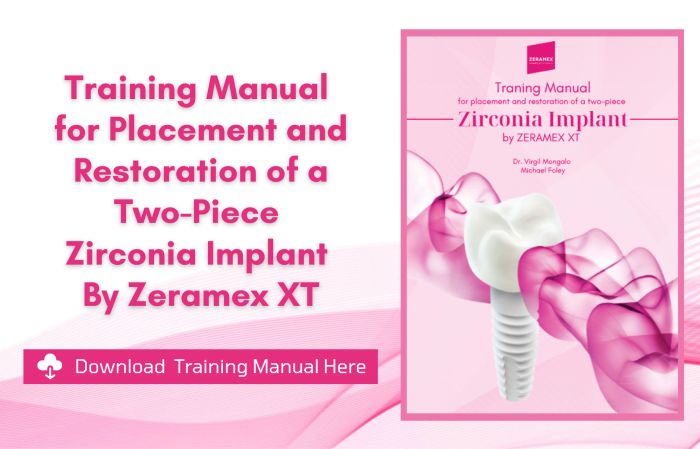An interview with Dr Elisabeth Jacobi-Gresser, Germany (pg. 34-36) | Vol. 6 • Issue 2/2022 – Ceramic Implants: International magazine of ceramic implant technology
“Retrospectively analysed, the long-term success rate of two-piece ceramic implants has been around 97% over all, with a very low incidence (approximately 8%) of peri-implantitis”, Dr. Jacobi-Gresser points out.
She was already critically concerned with the material titanium when it was still considered biocompatible and inert. Dr Elisabeth Jacobi-Gresser is a practising oral surgeon specialised in implantology, who is also a founding member of the German Society for Environmental Dentistry (DEGUZ e.V.) and former director of the Integrative Dentistry curriculum of the Dental Association of Rhineland-Palatinate (Landeszahnärztkammer Rheinland-Pfalz). As a board member of the DGZI, she is engaged to implementing ceramic implantology to certi ed modular education and explains in the following interview with ceramic implants—international magazine of ceramic implant technology, what modern two-piece ceramic implant systems can and must achieve today.
Dr Jacobi-Gresser, let’s begin with one of the most important questions for dentists who insert implants: You have accomplished follow-ups in patients with ceramic implant for many years. What long-term observations have you made over a period of more than a decade?
My experience with ceramic implants now extends back over 15 years. In the initial years, only one-piece implants of Y-TZP ceramic were available. The application was limited for known reasons. In strictly selected cases, specifically when treating a bounded edentulous space with optimal splinting during the healing phase, the long-term experience is extremely good. Over a period of 11 years, I have yet to see any late implant loss. Expanding the indication to include free end situations, I observed many early implant failures in the very early stage of ceramic implant development, so I very quickly ruled out this indication. Even today, I consider the early healing phase after insertion of a ceramic implant to be the “sensitive” phase. Retrospectively analysed, the long-term success rate of two-piece ceramic implants has been around 97% over all, with a very low incidence (approximately 8%) of peri-implantitis.
You use two-piece screw-retained ceramic implants. What is the percentage of these implants in your practice?
There was an initial transition phase following the introduction of the two-piece ceramic implants in 2009. The abutment implant connection initially was still cemented/glued, but since 2017, the year of introduction of the reversible screw-retained ATZ implants into the market, I have switched over entirely to these ceramic implants. In particular, this is due to my expertise in environmental oral medicine and the more comprehensive view of the immunological condition of the patient or compelled to the patient’s demand and expectation.
What experiences have you had with two-piece metal-free implants?
With the implementation of two-piece systems in 2009, my experience primarily has been focused on the ATZ implant system, which I retrospectively evaluate as very encouraging. After 30 years of experience with titanium implants before, I am especially excited about the excellent tissue reaction around the ceramic body, even in a long-term follow-up.
Many implantologists are especially focused on the topic of healing. Is there a difference in ceramic implantology?
The conditions for good healing are essentially comparable with titanium implant systems, as we know from
pre-clinical osseointegration studies. However, the lower inflaammatory reactivity of the immune system towards zirconia appeals for a more differentiated approach in planning the insertion of ceramic implants. As a result of the lower immunological reaction in terms of a less strong immune response to the foreign material, the osseointegration mechanism can be compromised, since the healing mechanism depends on adequate immune activity. The material itself requires a more “sensitive” approach: thread cutting is essential to minimize friction during the screwing procedure to avoid bone damage by heat.
An adequate immune reaction is required during the healing phase for the osseointegration. Of importance is the patient’s specific immune competence, too. The conditions for bone healing must be established based on a comprehensive patient history with information on medical restrictions as well as an analysis of key laboratory parameters. In addition to assessing the patient’s general inflammatory predisposition, that is a thorough clinical history, and to record the status with regard to micronutrients such as various minerals, vitamin D3, etc. I believe the importance of these aspects increases especially in times when our immune systems are under heavy assault as for example in a pandemic.
Many implantologists are especially focused on the topic of healing. Is there a difference in ceramic implantology?
The conditions for good healing are essentially comparable with titanium implant systems, as we know from
pre-clinical osseointegration studies. However, the lower inflaammatory reactivity of the immune system towards zirconia appeals for a more differentiated approach in planning the insertion of ceramic implants. As a result of the lower immunological reaction in terms of a less strong immune response to the foreign material, the osseointegration mechanism can be compromised, since the healing mechanism depends on adequate immune activity. The material itself requires a more “sensitive” approach: thread cutting is essential to minimize friction during the screwing procedure to avoid bone damage by heat.
An adequate immune reaction is required during the healing phase for the osseointegration. Of importance is the patient’s specific immune competence, too. The conditions for bone healing must be established based on a comprehensive patient history with information on medical restrictions as well as an analysis of key laboratory parameters. In addition to assessing the patient’s general inflammatory predisposition, that is a thorough clinical history, and to record the status with regard to micronutrients such as various minerals, vitamin D3, etc. I believe the importance of these aspects increases especially in times when our immune systems are under heavy assault as for example in a pandemic.
“An implant approach considering knowledge in clinical environmental medicine helps to meet requirements, patients with risk profiles afford.”
The grinding of ceramic implants is still a topic of discussion among implantologists. In your view, is it recommendable to grind ceramic implants in the mouth?
Studies give proof of increased particle load of the peri-implant soft and hard tissue after grinding of ceramic implants, which can cause a tissue reaction similar to the pro-inflammatory immune activation caused by titanium particles, although less severe. This probably could be one of the potential causes of reported tissue degradation processes associated with ceramic implants approved for grinding. In an animal model, our research group examined ceramic test objects that were externally cut and plasma-cleaned and compared them with test objects that were subjected to a final “finishing” of the surface as for a commercial ATZ ceramic implant surface. It was shown that the cut surfaces released significantly more zirconium and aluminium into the tissue. Further comparative studies in human tissue samples are required.
Various zirconium oxides are used for dental implants: ATZ, TZP and Y-TZP. How do they differ, and what are their advantages?
I consider them differing in terms of physical and chemical properties in relation to corrosion resistance and
stability, subsequently resulting in different effects with respect to corrosion debris in biological tissue. An implant fracture due to mechanical overload unfortunately implies a total failure due to material break down. Extensive comparative study results exist for screw-retained ATZ ceramic systems regarding stability under load and surface ageing compared with titanium. With regard to particle-induced toxic effects on tissue cells, comparative data are available for Y-TZP and titanium implants in animal models.
You mentioned the patient’s immunological response. Does everyone respond the same?
In scientific studies it has been shown that both the genetic predisposition for increased inflammatory response as well as the individual immunological hyperreactivity to foreign substances like particles can trigger pro-inflammatory effects in humans. We should therefore pay attention to the patient’s individual susceptibility.
An individual risk assessment should be included in the planning process of an implant approach to minimize the risk of impairing the patient’s health and to maximize the implant success in a long-term period.
Which values matter here?
In addition to evidence of a chronic “career of health deficiency” of the patient, appropriate laboratory analyses are also available for determining the individual genetic
inflammatory predisposition. Laboratory blood assays are performed in specialized immunological laboratories for various implant materials. There have been functional tests available for years and innovative ones are currently under development, which have to be confirmed in clinical studies. An implant approach that considers knowledge in clinical environmental medicine helps to meet the needs of patients with risk profiles. We are able to select a better-tolerated implant material. The genetic predisposition is a given, but we can diminish the burden of harming epigenetic phenomena by avoiding invasive pro-inflammatory triggers.
What do you think of the new German S3 guidelines for two-piece ceramic implants?
The new S3 guidelines on ceramic implants consented to in September 2021 confirm the applicability and long-term success of one-piece implants, and two-piece ceramic implants are at least regarded as an option. The new guidelines will give support to the implantologists in conflict with private insurance companies, that still refer to the old guidelines from the year 2017. Only a few of them still refuse to refund the costs. The official publication of all new S3 guidelines in implantology is expected in the very near future.
About the Doctor

Dr. med. dent. Elisabeth Jacobi-Gresser
Dr. Jacobi-Gresser obtained her Doctor of Dental Medicine diploma from Johannes-Gutenberg-University in Mainz, Germany. She received advanced training in oral surgery at University of Mainz achieving specialty status in Oral Surgery and Dental Implantology. She is a member of the examination committee in Oral Surgery in Mainz. Dr. Jacobi-Gresser has furthered her knowledge of medicine by pursuing continued education in homeopathy, applied kinesiology,
traditional Chinese medicine, environmental medicine and environmental dental medicine. She has conducted and published research on the immunological aspects of odontology and the role of genetic markers associated with periodontitis and implant failure. She practices in partnership with Dr. Peter Gresser in Mainz, Germany.
Contact
Want to know more about Zeramex?
Email us at [email protected] with your contact details and we will get in touch with you!
ZERAMEX BROCHURE
Click here to download the Zeramex sales brochure

